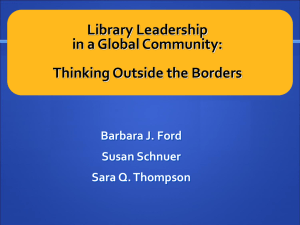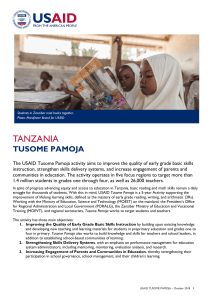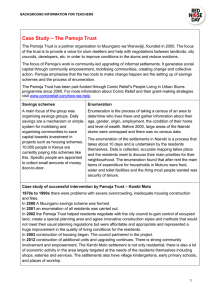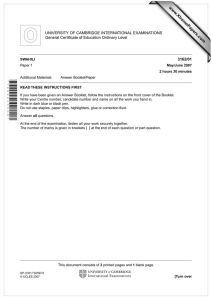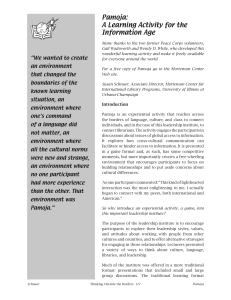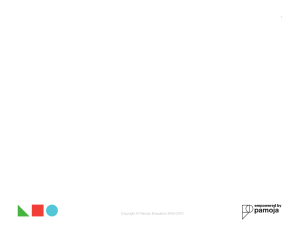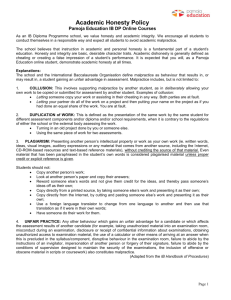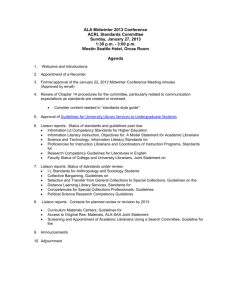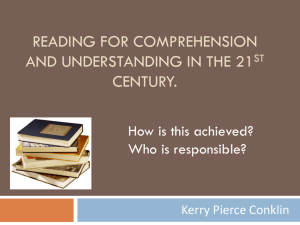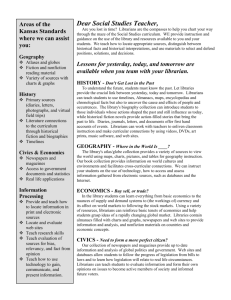View/Open
advertisement
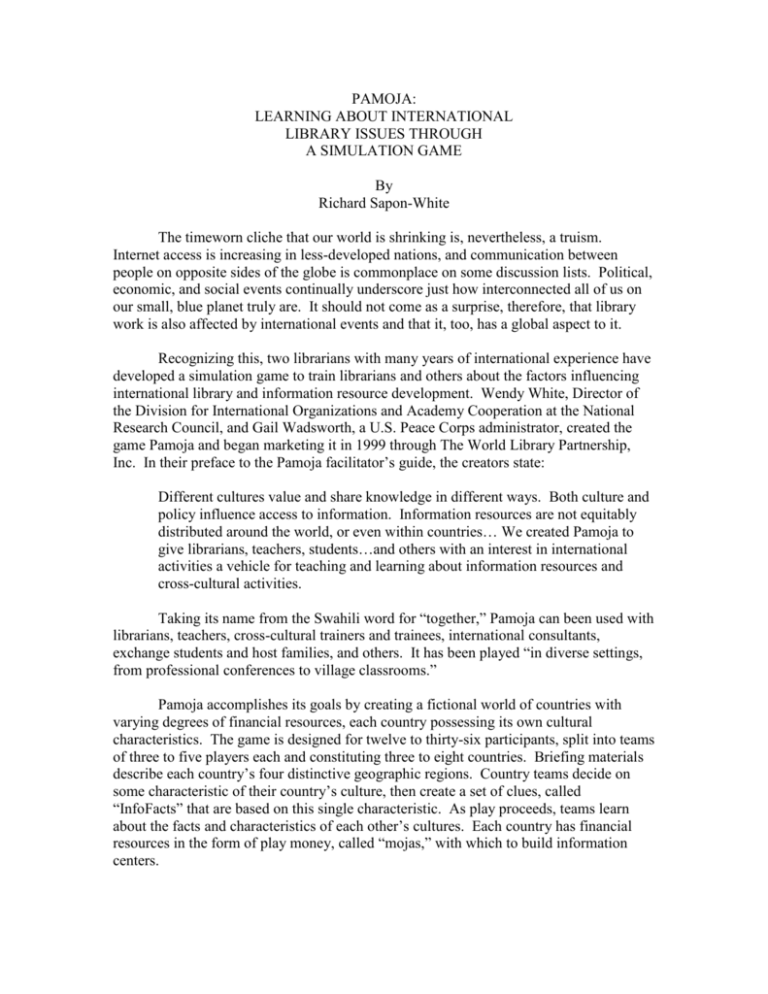
PAMOJA: LEARNING ABOUT INTERNATIONAL LIBRARY ISSUES THROUGH A SIMULATION GAME By Richard Sapon-White The timeworn cliche that our world is shrinking is, nevertheless, a truism. Internet access is increasing in less-developed nations, and communication between people on opposite sides of the globe is commonplace on some discussion lists. Political, economic, and social events continually underscore just how interconnected all of us on our small, blue planet truly are. It should not come as a surprise, therefore, that library work is also affected by international events and that it, too, has a global aspect to it. Recognizing this, two librarians with many years of international experience have developed a simulation game to train librarians and others about the factors influencing international library and information resource development. Wendy White, Director of the Division for International Organizations and Academy Cooperation at the National Research Council, and Gail Wadsworth, a U.S. Peace Corps administrator, created the game Pamoja and began marketing it in 1999 through The World Library Partnership, Inc. In their preface to the Pamoja facilitator’s guide, the creators state: Different cultures value and share knowledge in different ways. Both culture and policy influence access to information. Information resources are not equitably distributed around the world, or even within countries… We created Pamoja to give librarians, teachers, students…and others with an interest in international activities a vehicle for teaching and learning about information resources and cross-cultural activities. Taking its name from the Swahili word for “together,” Pamoja can been used with librarians, teachers, cross-cultural trainers and trainees, international consultants, exchange students and host families, and others. It has been played “in diverse settings, from professional conferences to village classrooms.” Pamoja accomplishes its goals by creating a fictional world of countries with varying degrees of financial resources, each country possessing its own cultural characteristics. The game is designed for twelve to thirty-six participants, split into teams of three to five players each and constituting three to eight countries. Briefing materials describe each country’s four distinctive geographic regions. Country teams decide on some characteristic of their country’s culture, then create a set of clues, called “InfoFacts” that are based on this single characteristic. As play proceeds, teams learn about the facts and characteristics of each other’s cultures. Each country has financial resources in the form of play money, called “mojas,” with which to build information centers. In order to build the information centers, players take on specific roles on their team. For example, Ambassadors go on information searches to other countries. While there, they negotiate with the Country Representatives in order to collect InfoFacts. Gatekeepers control borders, allowing entry according to criteria created by each country. Donors establish criteria for funding projects and parcel out mojas for them. Storekeepers/Bankers sell information centers, pay Ambassadors, and validate information searches. Play takes about three hours, including orientation, play, and debriefing. Facilitators provide set-up, orientation and play coordination. Instructions and photocopying masters are provided in the facilitators’ 150 page manual. Following play, participants debrief by discussing their countries’ cultural characteristics, their roles, and analyzing how the game played. A variety of topics can be discussed, including crosscultural relations, sustainable library development, cooperation and competition, teamwork, negotiation, and equitable access to information. The game creators state that the game plays differently each time and it is possible to explore different topics depending on the intention of the sponsoring organization, the players, and how the game unfolds. Significantly, although Pamoja focuses on important (and in the real world sometimes divisive) issues, the play is done in a relaxed, fun atmosphere. This enables participants to enjoy learning just how interdependent the peoples of the world really are. The game sells for $44, including shipping and handling. The packet includes a binder of instructions which the facilitator(s) needs to read in advance for preparation, as well as a list of other materials (pens, markers, poster board, playing pieces, etc.) which need to be purchased or prepared in advance. OLA’s International Relations Round Table (IRRT) recently purchased a copy of the game and, by the time this issue comes out, a group of its members has had a chance to practice playing Pamoja. The round table plans to offer opportunities to play the game this winter for a fee in an effort to both increase OLA members’ awareness of international issues as well as raising funds for its ongoing activities. IRRT also hopes to facilitate play of the game for Oregon libraries and others requesting it in the future.
